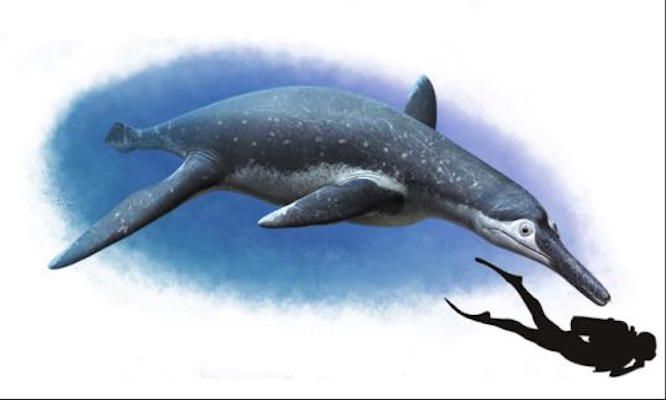Massive Marine Reptile Terrorized Squid During the Dinosaur Age

A newly identified, 130-million-year-old marine reptile was enormous, measuring the length of nearly three grand pianos lined up, but it wasn't a top marine predator, a new study finds.
Researchers excavated the remains of this pliosaur — a type of short-necked plesiosaur with four flippers that lived during the dinosaur age — along the banks of the Volga River, near the Russian city of Ulyanovsk, in the fall of 2002. Now, scientists have classified the ancient marine reptile as a new species.
Unlike other pliosaurs, such as Pliosaurus funkei and Liopleurodon, which had larger teeth and likely dined on sizable four-legged prey, the newfound pliosaur probably wasn't a top predator, as it had "fairly small" teeth and likely hunted small prey such as cephalopods, including squid, and small fish, said study lead researcher Valentin Fischer, a lecturer in the geology department at the University of Liege in Belgium. [Photos: Uncovering One of the Largest Plesiosaurs on Record]
The scientists named the 26-foot-long (8 meters) newfound beast Luskhan itilensis. The name reflects the region's cultural history, as the area used to be part of the Mongol Empire. In Mongolian and Turkic mythology, "luuses" were spirits and masters of the water. "Khan" is the Mongolian word for "chief."
The species name refers to "Itil," the Volga River's ancient Turkic name. (Turkic refers to groups of people who used and still do live in the region.) Thus, the reptile's name essentially translates to "master spirit from the Volga," the researchers said.
L. itilensis' skull was long — 5 feet (1.5 m) — and its snout resembled those of the modern-day river dolphin and gharial, a long-snouted crocodile.
"We show that pliosaurids have actually evolved a long-snouted, 'piscivorous' [fish-eating] ecological niche multiple times in their history," Fischer told Live Science in an email. "Each time they have done this, they have actually evolved convergently with another, distantly related group of plesiosaurs called the polycotylids."
Sign up for the Live Science daily newsletter now
Get the world’s most fascinating discoveries delivered straight to your inbox.
Convergent evolution happens when two species with similar lifestyles evolve to have similar adaptations, such as a long snout. In this case, the finding shows that plesiosaurs had more convergence than previously thought, Fischer said.
The L. itilensis discovery shows that a diverse number of pliosaurs lived during the early Cretaceous, even after the Jurassic-Cretaceous extinction about 145 million years ago, "which is thought to have been a deleterious event in the history of plesiosaurs," Fischer said.
The specimen, which was discovered by study co-researcher Gleb Uspensky, director of the Natural Science Museum at Ulyanovsk State University in Russia, shows that pliosaurs bounced back after the Jurassic-Cretaceous extinction, Fischer said.
The study was published online yesterday (May 25) in the journal Current Biology.
Original article on Live Science.

Laura is the archaeology and Life's Little Mysteries editor at Live Science. She also reports on general science, including paleontology. Her work has appeared in The New York Times, Scholastic, Popular Science and Spectrum, a site on autism research. She has won multiple awards from the Society of Professional Journalists and the Washington Newspaper Publishers Association for her reporting at a weekly newspaper near Seattle. Laura holds a bachelor's degree in English literature and psychology from Washington University in St. Louis and a master's degree in science writing from NYU.












